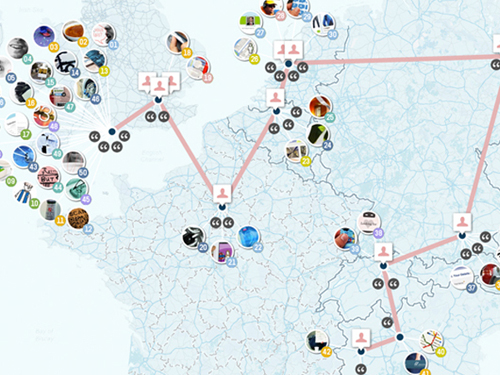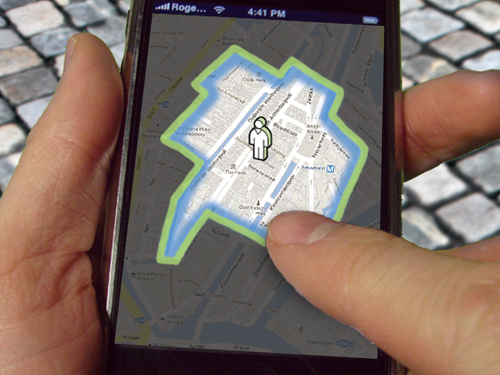I’ve travelled 2517 miles to try to solve 50 problems in 50 days using design, a journey that challenged me to fundamentally rethink my understanding of the user-experience design process.
I set myself a challenge. I wanted to test the limits of design’s ability to solve problems — big and small. To do this, I left the comfort of my computer chair and set out into the unknown. Every day, I had 24 hours to observe a problem, attempt to solve it and then communicate the solution.
For more of an introduction to the adventure, “50 Problems in 50 Days, Part 1: Real Empathy for Innovation” gives an overview of the project, as well as argues for the importance of real empathy in developing truly problem-solving solutions. For more, take a look at the 50 Problems in 50 Days website.
Further Reading on SmashingMag:
- 50 Design Problems In 50 Days
- Design Something Every Day!
- How To Make Innovative Ideas Happen
- Lessons Learned From A First-Time Appreneur
In this second of three articles, I’ll share what travelling 2517 miles taught me about not knowing and about the value of incompetence in fostering innovation — in other words, how I learned that being an idiot is OK for me, and is OK for you, too.
Day 42: Homelessness
It was 7:00 am, and the sun was already shining in beautiful Turin. Leaving my hostel early, I set out to find my problem to tackle that day. I found myself walking with commuters, immersing myself in my surroundings and observing.
As I walked one of the city’s many high streets, I passed shops that were not yet open. Looking around me, I gradually became aware of shapes by the side of the road. Looking closer, I realized there were people asleep in the doorways of the stores.
I was familiar with homelessness, having researched the problem in a past project and having witnessed it in several cities during my adventure. However, I was more conscience of it here in Turin.
I stopped walking and thought.
Assessing what I was seeing — and perhaps in a moment of foolishness — I decided to make homelessness in Turin my problem for the day. My question became, How can design address the problem of homelessness in Turin?
I knew that trying to tackle homelessness in 24 hours was a ridiculous undertaking. However, with my knowledge and research, I had some experience to direct my thinking.
I got to work.
I began by interviewing passersby about what they knew of the problem in the city and about the social and political factors that might have led to people living on the street.
I observed people interact with the homeless.
I analyzed. I created mind maps documenting what I knew of the interdependent factors relating to homelessness, analyzing perceptions and comparing them to the realities.
I worked. And I worked. And I worked.
And I came up with absolutely nothing.
My effort resulted in pages of notes, yet I struggled to come up with any tangible ideas. The ideas that came to me seemed inadequate to the complexities that I knew of the problem.
I was getting nowhere.
Exhausted, I sat down at the edge of a busy public plaza.
As I did, my eyes adjusted to the surroundings. In the corner of the plaza sat a middle-aged woman. She was dressed in black and was looking down at her feet. I soon realized that she was begging.
Observing her interact with passersby, I realized something important: that I knew nothing about her.
Until that point, my work had been directed largely by my past experience with this problem, rather than by what I was seeing right in front of me. In a moment of foolishness, I decided to scrap all of my day’s work so far and start again.
Standing up, I left the plaza and went back to observation, research and analysis. This time, I approached the situation afresh. As I spoke with people, I tried to re-understand the problem as if I had never dealt with it. In doing so, I based my questions not on what I thought I knew, but on a search for new insight.
I turned a corner, and suddenly there was a flash in front of me.
An elderly lady was coming right towards me! Before I knew it, she was clutching at my shirt sleeves, speaking to me in fast pigeon-English, asking for money!
My mind raced.

A simple interaction took me completely by surprise. (Image: Bogan Suditu)
Questions started popping into my head, great questions that built on my previous research, questions that recognized the complexity of the problem! But stopping myself from focusing on what I thought I knew, I decided to ask her one simple, naive question:
What do you need my money for?
As she answered, something unanticipated happened. She told me why she needed any change I could spare, and as she did so, I forgot all of my questions and listened to what she was saying. In that moment, I suddenly understood the problem.
As she spoke, I found myself faced with a very human dilemma.
On the one hand, I wanted to give and to be compassionate. On the other hand, I didn’t know how my money would be spent and was concerned that it might be used irresponsibly. In the end, I didn’t give.
This one simple insight sparked a multitude of ideas in my mind and led to my eventual solution.
Where my foreknowledge and experience had taken me in circles, being prepared to forget what I knew and approach the problem naively yielded insight as clear as day. I was able to tackle this problem not because of my competence in it, but because I was prepared to be incompetent.
Not Knowing
Trying to solve 50 problems in 50 days demonstrated to me the value of incompetence in solving problems and the danger that competence sometimes presents.
From checkout processes to apps, we build up proficiencies in how to solve certain types of problems during our careers as designers. This, coupled with repeated exposure, enables us to develop a measure of expertise in our field.
Every designer should strive for expertise. However, my adventure taught me that sometimes this expertise can make us neglect a vital tool in truly solving problems: It can make us forget “not knowing.”
Our accumulated expertise enables us to quickly establish how to tackle a particular challenge, the factors related to the problem and the limitations of our reach. While this experience is vital, familiarity with a problem can also restrict us to routine ways of thinking and can prevent us from seeing beyond what we know and discovering what we don’t.
As designers, the quality of our solutions will always be fundamentally linked to our understanding of the problem. Learning to approach both new and familiar problems naively enables us to do something important. It enables us to look beyond what we think we know and to fully immerse ourselves in the problem we are trying to solve.
Innovation In Incompetence
From asking “Why is a used toilet roll on the floor?” in Berlin (day 32) to questioning why people keep getting hit by bikes in Amsterdam (day 28), I unearthed unanticipated insights from otherwise ordinary situations by approaching problems naively. This did not negate my knowledge; rather, it enabled me to spot assumptions and limitations in my thinking. In doing so, I was able to discern more accurate insights and to foster more effective solutions.

Documenting the people-weaving techniques of cyclists in Amsterdam on day 28
Being prepared to “not know” is difficult. Everything we think to be true in life is based on what experience has taught us. Therefore, being prepared to approach a familiar design challenge naively is difficult. In short, it can make us feel a little stupid and challenge our desire for expertise.
Ultimately, though, trying to solve 50 problems in 50 days taught me that real design expertise isn’t always about knowing the right answers, but in knowing when and how to ask the right questions.
From responsive design conventions to e-commerce store layouts, when we are prepared to re-evaluate what we know and to approach familiar problems afresh, we give ourselves vital opportunities to better understand and better solve those problems.
Methods For Anyone And Everyone
Below are just some of the methods I developed in my journey. Use them, build on them, and develop your own. Our aim should be to find methods to more deeply understand the problems we are trying to solve and, in doing so, to better serve the people we are designing for.
Choose to Not Know

Creating an interactive communication tool for hostel staff on day 29
When we’re briefed on a design problem, more often that not our brains start to do something amazing: They start to solve. We find points of reference to frame the challenge by recalling experiences that might help.
Suppose we’re given a brief to “design a website to help festival-goers find music venues.” Upon hearing this brief, we’d have two choices. Choosing to momentarily put our experience to one side and “not know” what this solution might look like accomplishes two things:
- It compels us to dig deeper. Starting with no answers compels us to dig deeper to find the best solution, rather than be drawn to the obvious half solutions that might meet the need. Being prepared to approach a new problem naively forces us to immerse ourselves in the world of the people we are designing for. Rather than let our experience direct our thinking, by saying “I don’t know,” we make ourselves really pay attention to the people who do.
- It fosters creativity. Not retreating to past experience opens our mind to consider solutions beyond what we know. These solutions could be better, more inventive and more intuitive — we just have to be prepared to look for them.
Ask Stupid Brilliant Questions

Designing a simple tool to locate and navigate to free Wi-Fi on day 35
In my journey, I learned that one of the best methods for unearthing valuable insight from familiar design challenges is to ask (seemingly) stupid questions.
Suppose we’re asked to create a website to help someone sell their home. Our experience could give us useful shortcuts to skip the basics in order to deal with more unknown aspects of the project. However, rather than asking “What content should go on this website and how shall we structure it?”, asking a naïve question like “Why do people sell their home?” or even “Why do you need a website to achieve what you want?” could unlock insights that shape the entire direction of the project.
Likewise, asking naïve questions of the people we’re designing for gives us an opportunity to listen and to challenge our assumptions about the problems they face. Rather than asking end users “What specific resources would you like to help you sell your home?” making a naïve statement like “I’ve never sold a house before. What’s it like?” helps to dig below the surface to root out the underlying problem.
Question Convention

Creating an interactive and non-invasive tool for crowdsourcing book notes on day 47
Designed conventions are vital. By including conventions in our products, we are giving users a shorthand to more easily understand and use the solutions we have created for them. However, while the conventions we use are often an excellent shorthand, they are not necessarily the best way to solve the problems we’re tasked with.
Experience teaches us that certain problems can be solved with conventional solutions. It is easy to assume that a wayfinding problem is best solved with a map. While conventions enable us to solve quickly, innovation is born of a natural distrust of convention and a desire to create smarter, more intuitive experiences. Suppose we’re asked to create a music discovery service. In digital applications, music is conventionally represented as images of album artwork or as rows in tables. Following suit and having users browse music in this way would be easy. But our aim should be to create a solution that better meets the needs of the people we are designing for. In almost every other situation, discovering music is rarely a visual experience — it’s auditory. How would this affect the decisions we make when designing this service?
For a great (and really simple) example of this in practice, look at Christian Holst’s article on “Redesigning the Country Selector.” Regardless of whether you agree with his solution, challenging convention enables us to create smarter, more effective outcomes.
These are just some of the methods by which we can embrace naivety and challenge what we think we know in order to better solve for the people we are designing for.
It would be ridiculous to overlook the role of convention and the role of experience in creating intuitive, useable products. But by being prepared to challenge what we know, we set ourselves up to discover what we don’t.
The Solution
So, what was the result of overlooking my experience, re-evaluating what I thought I knew and re-approaching the problem with the mindset of a beginner?
Sitting down outside a metro station in the centre of Turin, I reconsidered my dilemma of being asked to spare some money.
On the one hand, I wanted to give and be compassionate. On the other hand, I didn’t know whether my money would be used responsibility. In the end, I didn’t give.
As I sat outside the station, I looked up to see commuters ascending the stairs from the underground platform. Reaching the top of the stairs, they would throw away their travel ticket and continue their journey.
Watching this simple action was my eureka moment.
The solution I created would repurpose Turin’s metro system. When buying a ticket, the buyer would be invited to donate a tiny amount (as little as €0.20).
Then, when leaving the station, instead of throwing their ticket away, they would be able to leave it in the hat of someone living on the street, a donation that could be converted to a night’s stay at one of Turin’s shelters.
With this solution, people could be compassionate while knowing exactly how their donation will be used.
Since publishing 50 Problems in 50 Days, this solution has been one of the most shared and most discussed. Being contacted by organizations and individuals around the world to discuss how to implement comparable solutions in their cities has been amazing.
Conclusion
Being prepared to re-approach design challenges naively is vital to innovation. From shopping carts to apps, our accumulated experience helps us to confidently solve based on what we think to be true. However, it can also negate one of our greatest assets as designers: humble incompetence.
Even in the most familiar of situations, when we are prepared to “not know” our client’s business (say, the format of a website or the mindset of the user), we are able to expose our assumptions and seek new insight. In doing so, we empower ourselves to better understand the problem and to foster a more effective solution.
Ultimately, we must dig deeper into the problems we are tasked with solving and aim to better solve for the people whose lives we are affecting every day.
In the words of Irene Pereyra, Global Director of UX and Strategy at Fantasy Interactive:
In order to be innovative, you have to be fearless, you have to be comfortable with being different, and you have to be willing to stand apart from the crowd… In order to be forward-thinking you have to let go of the status quo, and you have to rephrase the problem.
Stay tuned for the final part of this series on my 50 problems. In it, I’ll share a selection of small lessons on what travelling 2517 miles has taught me about process, discipline, innovation and the power of design to solve problems big and small.
 (al)
(al)













